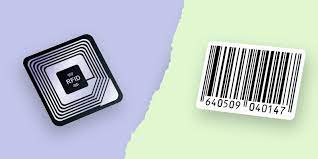The advantage of RFID over barcode

One of the best known technologies in the field of automatic identification is the bar code. Compared to barcodes,
RFID offers the following advantages
- contactless reading and writing;
- work out of line of sight;
- long reading range;
- overwriting data;
- large amount of data;
- durability of the tag.
Advantages of RFID technology over bar coding.
The data from the tag is read in a non-contact way.
In this case, the tag should not be in the reader’s field of view and can be hidden inside the product or its packaging.
ID tag data can be supplement

The barcode data is record only once (when print) and the information store in the RFID tag can be change, supplement or replace by other information under the right conditions.
Much more data can be written to the tag

Conventional bar codes can contain information of no more than 50 bytes (characters), and to reproduce such a character, an area the size of a standard A4 sheet is require . An RFID chip can easily store 1000 bytes in an area of 1 square centimeter.. The placement of information with a volume of 10,000 bytes does not represent a serious technical problem.
Data on the tag is enter much faster

The barcode usually requires its symbol to be print directly on the packaging material or on a paper label. RFID tags can be embed in the bottom of the pallet or the original packaging and can be use throughout the entire life cycle of a shipment. Data on the contents of the package itself is capture contactless in less than 1 second.
The data on the tag can be classified

Like any digital device, RFID tags can be password protect to write and read data. This information can also be encrypt. Private and public data can be store in the same tag at the same time. This makes RFID tags ideal for protecting goods and property from counterfeiting and theft.
RFID tags are more durable

In areas where the same tag object can be use countless times (for example, when identifying pallets or returnable containers), RFID is ideal as it can be use 1,000,000 times.
Longer reading distance of RFID tags
The reading radius of RFID tags can be up to several hundred meters, depending on the label model and the reader, which is an advantage when taking inventory in large, busy warehouses or for goods of non-standard dimensions.
Supports reading multiple RFID tags at the same time
The processing of multiple (for industrial readers, the indicator can reach thousands of units per second) of tags became possible thanks to the introduction of the so-call anti-collision function. RFID tags do not need to be place on the outside of the package (object). Therefore, they are better protect in the conditions of storage, handling and transportation of logistic units.
The tag is better protect from environmental influences
| Technology characteristics | RFID | Barcode |
| Need for line-of-sight labels | reading even hidden tags | reading without line of sight is impossible |
| Memory | 10 to 10,000 bytes | up to 100 bytes |
| Data rewritable and tag reusable | there is | No |
| Registration range | up to 7 m | up to 6 m |
| Simultaneous identification of several objects | up to 600 marks per second | impossible |
| Resistance to environmental influences: mechanical, temperature chemical, moisture | increased strength and resistance | extremely easily damag |
| Label lifetime | more than 10 years | short |
| Security and anti-counterfeiting | counterfeiting is almost impossible | easy to fake |
| Identification of moving objects | Yes | difficult |
| Use of both stationary and hand-held terminals for identification | Yes | Yes |
| Identification of metal objects | possible | possible |
| Price | average | low |
According to IBM
IBM has provide the following data on the implementation of RFID technologies in the process of shipment of goods. It took the distributor 17 minutes and 20 seconds to ship one pallet with a valid order. If a distribution center sends 1,000 to 1,500 pallets per day, then the end result is an additional 28.89 to 43.33 hours per day. The company pays $ 10 for every hour they work. Then an amount from 288, 90 to 433.30 dollars will be spent daily on wages. This would result in an overhead of $ 75,114 to $ 112,658 per year if the production year is 260 days. All these costs can be offset in other areas. With the introduction of RFID technology, the time to ship one pallet has been reduced to 32 seconds. Therefore, the processing time for one pallet can be reduced by 96%.This is in the absence of any exceptional situations. If the distribution center handles 1,000 to 1,500 pallets per day and 80% of the time is free from exceptions, then 277.78 to 416.68 hours per day can be save for this particular application model. Let the company pay $ 10 per hour. Every day you can save from $ 2,777.88 to $ 4,166.80, and that’s just on labor costs.


